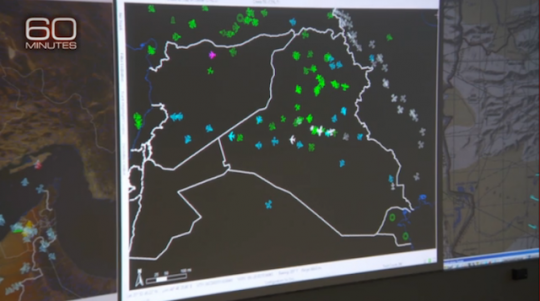The most telling moment in 60 Minutes’ report this weekend on the fight against the Islamic State, "Inside the Air War," passed without comment. As correspondent David Martin took a tour of the Qatar-based combat operations center from which the air war is coordinated, there was a brief camera shot of a screen showing the location of aviation assets across the region. The image showed that there were a couple of dozen or so friendly aircraft in the skies above Iraq—but over Syria, where the U.S. has few friends on the ground and is being pushed aside in the skies by the Russians, it appeared that there were only two or three.
That tells a story, but not a story about which the Pentagon wants you to reflect. The Pentagon would rather you consider the map they provided to 60 Minutes showing territorial losses by the Islamic State since the beginning of the air campaign. Indeed, the Caliphate has lost Tikrit, in a coalition campaign waged with significant participation by Iranian-backed militias. But it retains Mosul and has captured Ramadi during the same period of time. At the very best, this map shows that 20 to 30,000 poorly trained, loosely organized jihadists have fought a coalition that includes the world’s most powerful military to a stalemate.
Speaking of those 20 to 30,000 enemy fighters, the U.S. military would like you to know that they are being killed at around the rate of 1,000 per month. To his credit, Martin finds this a little bit confusing and points out that the total estimate for enemy fighters remains unchanged from 2014, when it was also 20 to 30,000. Martin asks the officer leading him on his tour, "So as long as they can keep bringing fighters in there, are you just shoveling sand against the tide?" The response: "I don't know if that's the way I'd put it. You have to eliminate folks. You have to take the enemy off the battlefield. And as they put new folks in, they're not as seasoned and capable, and we'll take them out too."
This at least has virtue as a jobs program for both terrorists and American air crews, inasmuch as it could apparently go on forever. Pressed by Martin to explain the lack of progress, the commander of the air war, Lieutenant General Charles Brown—ISIS isn’t holding a football, is it?—blames his "partners," clearly meaning the Iraqi government: "It is in some regard and part of this is that we're not only are we working at the pace of the way we would operate, but it's also the pace of where our, our partners operate. It is a team effort and ideally you know we'd like to move—I think collectively we'd all like to move faster."
Like a rifle squad, this vast campaign can apparently only go at the speed of its slowest member. President Obama has set as his goal to degrade and ultimately defeat the Islamic State, but has imposed this critical restriction on his military: the ground fighting must be done by local allies. But if we are serious about one day defeating these mass-murdering, mass-raping enemies of civilization, the fact of the restriction raises a question: what if our local allies can’t do it? Not today, not tomorrow, not ever? What if they just don’t have the juice, no matter how many bombs we drop for them? As this is, from a point of view of formal logic, possible, what is our timeline to determine whether or not they are capable? Because if they are not capable, but we actually are serious about eliminating the Islamic State, it follows that we’ll have to do it ourselves.
We don’t have such a timeline because, while eliminating the Islamic State is a goal of this administration in the Middle East, it is not the most important goal. The most important goal is a withdrawal of the United States from a position of dominant power in the region, to a position where it is one nation among many working toward responsible international goals. This goal is important, believe those in the White House, both because the United States has other priorities beyond the Middle East that require its attention, but also because many of the problems in the Middle East exist because of U.S. involvement in the region. Our withdrawal is good for us, and good for them.
The president and his senior aides do not think that a Middle East where Russia and Iran command equal or greater influence than the U.S. must be an objectively worse place. The U.S. is itself morally compromised, and to the extent that Iran and Russia can behave problematically, the fact is with less pressure placed on them by American hawks, the more moderate elements of their societies will come to the fore, and the arc of their behavior will bend towards justice.
The success of the strategic realignment is dependent upon the continued support of the American people, who don't like casualties but also don't like to think their military is losing: hence the war for the media and for public opinion. Actual progress against the Islamic State is a purely secondary concern. That’s why, despite our apparent failures on the battlefield, we shouldn’t expect any changes coming from the White House. For them, the war is going just fine.
